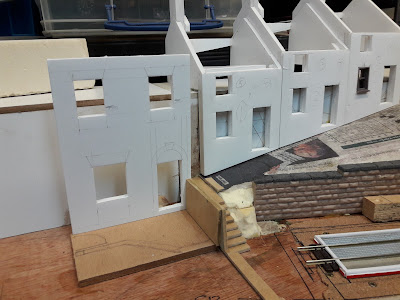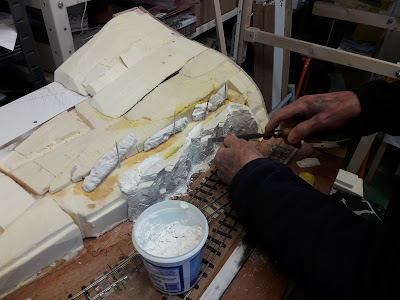Rocks.
Managers house/office.
Windows.
Yard underlay.
Geoff & Stephen today.
Geoff had been working on the rock face and surrounds in the week and now carried on carving and filling. Later, he tidied up the sleepers in the area and gave them an undercoat of dark paint.
Stephen had re-made the front of the managers office (official name now) a bit taller, which looked much better. He then spent ages trying to work out how to resolve the area in front of the office, the junction of the cottage path and the alleyway, and how pedestrians got down to yard level. A small section of wall was created, which resolved the height difference between the areas, then a landing and a flight of steps resolved the other two issues. A walled area with a gate outside the office has been sketched and we'll see how that develops.
Where and how people negotiate the yard once down at ground level has been a bit ad hoc. Geoff is adamant that people would not have been stopped from wandering through the yard, but equally, a safe/official route made more sense. A legitimate path was now traced around the edge of the yard area avoiding the dangerous corner of the engine shed and out onto the road. It made sense and should provide a few more modelling features.
Geoff had modified the 3D printed cottage window design to reduce the size of some elements, which looked much better. There are separate pieces for the inner and outer sashes. He'd also made windows for the engine shed, which also looked great.
Finally, the rail-height yard construction was discussed - again. Geoff was keen to keep the amount of plaster to a minimum, partly for weight, but mainly for concern about cracking. He proposed starting with a layer of foam, then some papier mache, finishing with a thin coat of plaster and /or scenic grit to achieve a compacted earth finish. A piece of the XPS block he'd purchased for buildings, was put through the band saw to produce 5mm sheets. A few pieces were glued down as a trial. It is nicely flexible, but very strong and went down extremely easily.







































